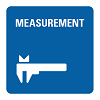- Subscribe to RSS Feed
- Mark Topic as New
- Mark Topic as Read
- Float this Topic for Current User
- Bookmark
- Subscribe
- Mute
- Printer Friendly Page
CLDR Sample Exam Question
Solved!02-04-2010 10:58 AM
- Mark as New
- Bookmark
- Subscribe
- Mute
- Subscribe to RSS Feed
- Permalink
- Report to a Moderator
I was going through the CLD recertification sample exam (here), and one of the questions has me stumped. For question 39, I understand what the code is doing and the right answer, but I can't seem to find how to place this code on a block diagram. I'm referring to the function with the -3->, ?, and i on the icon. Can anyone tell me where on the function pallete to find this (LV2009 or 8.6)?
Thanks ahead!


Solved! Go to Solution.
02-04-2010 11:44 AM
- Mark as New
- Bookmark
- Subscribe
- Mute
- Subscribe to RSS Feed
- Permalink
- Report to a Moderator
Wow, that one took me a while to figure out. That object is a Feedback Node, but with a funky configuration. You have to change its direction (so it's a feed forward node), then you have to right-click and choose "Properties" to change the delay to '3'. Once you do that it should be configured like the one in the screenshot of the exam, as so:

02-10-2010 10:23 AM
- Mark as New
- Bookmark
- Subscribe
- Mute
- Subscribe to RSS Feed
- Permalink
- Report to a Moderator
I'm still stumped here. I haven't installed 2009 yet and can't find the delay properties in 8.6, was is added for LV 2009?
Also, the possible answers are
a. {-2, -1, 0, 1, 2, 3}
b. {-2, -1, 0, 0, 1, 2}
c. {2, 1 0, 0, 1, 2}
d. {2, 1, 0, -1, -2, -3}
With "C" being listed as the correct answer. My answer would be "E" none of the above. You can't have a for loop iterating 6 times with 5 indexed outputs. So based on this the answer would have to be missing a comma or else I really have no understanding here.
Now the most important question, name one instance where you would use this rediculous function?
Thanks,
Dave
02-10-2010 10:51 AM
- Mark as New
- Bookmark
- Subscribe
- Mute
- Subscribe to RSS Feed
- Permalink
- Report to a Moderator
Hi Dave,
Yes, the properties for the Feedback Node were added in LabVIEW 2009. Also, you're right about the missing comma. Answer (c) should be {2,1,0,0,1,2}.
I have already given some feedback (haha) to the certification team that, in my opinion, esoteric Feedback Node questions really have no place in these exams.
02-10-2010 11:07 AM
- Mark as New
- Bookmark
- Subscribe
- Mute
- Subscribe to RSS Feed
- Permalink
- Report to a Moderator
Thanks for the clarification Darren. I understand that they want to keep the tests current but this seems ludicrous. Few people seem to use feedback nodes anyway.
I do think I'm starting to understand the function, I just can't grasp a possible use case. At least now that I'm aware of it the use case may just smack me upside the head one day.
Thanks,
Dave
02-11-2010 12:47 PM
- Mark as New
- Bookmark
- Subscribe
- Mute
- Subscribe to RSS Feed
- Permalink
- Report to a Moderator
Well it's the same like this:
Allthough it is quite unclear to me why I had to reverse the first part of the array.
But a very advanced functionality, I like the way to initialize with an array.
Ton
Nederlandse
My LabVIEW Ideas
LabVIEW, programming like it should be!
02-12-2010 03:25 PM
- Mark as New
- Bookmark
- Subscribe
- Mute
- Subscribe to RSS Feed
- Permalink
- Report to a Moderator
TCPlomp wrote:
Allthough it is quite unclear to me why I had to reverse the first part of the array.
But a very advanced functionality, I like the way to initialize with an array.
Ton
I would say that you had to reverse the array because you wired the shift registers in reverse order. ![]() Following the arrows of the SR, the first initial value out is the bottom of the stack. This very reason is why I, like you, really like the new capability to initialize with an array.
Following the arrows of the SR, the first initial value out is the bottom of the stack. This very reason is why I, like you, really like the new capability to initialize with an array.
I think a question like this is ok for the tests (especially since I don't take them) if it is just one or two. I'd really love to know what percentage of people would get this right if it weren't multiple choice.
02-19-2010 09:50 AM
- Mark as New
- Bookmark
- Subscribe
- Mute
- Subscribe to RSS Feed
- Permalink
- Report to a Moderator
These feedback node configurations are used to make pipelined designs to run on FPGAs, where there is a common need to balance delays in parallel data paths. The feedback node gets you a much cleaner and more readable diagram for these applications; the multiple delay feature is just an extension to allow an efficient FPGA implementation and a more compact diagram representation for these delay balancing use cases.
That said, I agree that this should not be exam material unless knowledge of the FPGA module is a requirement of the test.
02-19-2010 10:45 AM
- Mark as New
- Bookmark
- Subscribe
- Mute
- Subscribe to RSS Feed
- Permalink
- Report to a Moderator
02-23-2010 07:37 AM
- Mark as New
- Bookmark
- Subscribe
- Mute
- Subscribe to RSS Feed
- Permalink
- Report to a Moderator
Darren wrote:Hi Dave,
Yes, the properties for the Feedback Node were added in LabVIEW 2009. Also, you're right about the missing comma. Answer (c) should be {2,1,0,0,1,2}.
I have already given some feedback (haha) to the certification team that, in my opinion, esoteric Feedback Node questions really have no place in these exams.
More than that. Some of us work for folks who can't yet afford the latest and greatest. I think any single version/latest version- unique question has no place in these exams. It's bad enough it costs 5K up front then another 1K every year to stay with the latest version.
LabVIEW versions 5.0 - 2020
“All programmers are optimists”
― Frederick P. Brooks Jr.

